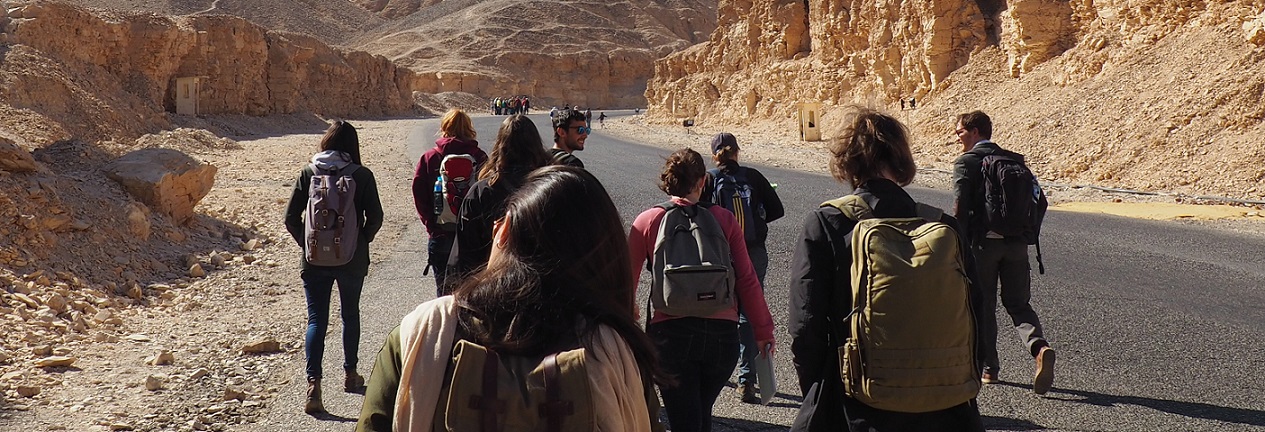Week 3: 22-29 January 2017
It is the third week of the program already, how time flies. It was our most quiet week so far, which however also meant that we had to do a lot of self-study. So our group spread out over the different archaeological and Egyptological institutes of Cairo to study in their libraries. Favourites being the French institute, which has the biggest library and offers great lunch buffets, the German institute, which is the second largest and is on Zamalek near to most people’s apartments and our own NVIC of course.
On Sunday afternoon we were given another seminar by Marleen on the archaeology of Deir el-Barsha. This time the focus lay on the Old Kingdom remains. Deir el-Barsha is pretty much Marleen’s project so we got all the interesting juicy details of the dusty desert of Deir el-Barsha. And we learned the reason why Egyptologist Harco Willems shaved his beard off ;) (follow this link if you want to know more http://nieuws.kuleuven.be/dodenmasker).

On Monday we gathered at the NVIC at 7am to leave for the Fayum region (although we could not enter the Fayum itself because of security reasons). We started with the site of Meidum which contains a pyramid of Snefru and its surrounding cemetery. A lot of crawling and climbing was in order. We first made our way into the pyramid where we visited some bats in the burial chamber and then we went down mastaba 17 through a robbers’ tunnel! That must be on the bucket list of every Egyptologist, crawling through a narrow dusty tunnel on all fours into a burial chamber. It was a real Indiana Jones experience and we loved it, no matter how dirty we came out again. Afterwards we walked a bit further out into the desert to the mastaba tombs of Nefermaat and Itet, famous for the painting of the Meidum Geese, now in the Egyptian Museum. After having said goodbye to an absolutely adorable puppy we moved on to Lahun/Kahun. On the site there is the Middle Kingdom mudbrick pyramid of pharaoh Sesostris II, a surrounding necropolis and a village of the workman of this necropolis. Sadly one cannot enter this pyramid so we walked around it and through the village. The village however is almost completely gone apart from mountains of pottery and occasionally some mudbricks and human bones. By this time it was really hot in the desert because the sun was beating down on us and there was little refuge of it. Then it was time to head back to Cairo. We had a bit of time off before we went to a lecture at the Italian Archaeological Institute by Rosario Pintaudi about Antinoupolis. The Italians were so kind to provide the audience with a large assortment of cakes and rolls afterwards, which were a great treat (especially for those who hadn’t had any dinner yet).
Late Tuesday afternoon we visited the Austrian Institute. It had a small but very cosy looking library, not too far away from all our apartments, so chances are this one will be added to the list of institutes to study in our ‘free time’. That evening we had a joint celebration of Guy’s and Nienke’s birthdays.

On Wednesday we were advised to stay indoors because it was the national holiday of the police and the anniversary of the revolution. Fortunately this was a very uneventful day.
Thursday was the last day we could make printed handouts for our site presentations next week, which brought us all together in the NVIC. We also had a briefing for the trip by Marleen in the afternoon so we would know what to expect. Later in the evening we attended a lecture by Suzanne Onstine about the tomb of Panehsy in Thebes.
On Saturday (that is if you can call the middle of the night Saturday already) we had to gather at the NVIC at 3am to get into the bus to the airport. Our plane left at 6am for Luxor, where we landed an hour later. Headed for our hotel, checked in our bags, shoved some breakfast down on the roof terrace and then went on to the Valley of the Kings. Here we first visited the archaeological mission of the University of Basel led by Susanne Bickel. Their project focuses on the non-decorated, non-royal tombs in the Valley of the Kings and the team was so kind to show us some of their finds including pottery vessels and cartonnage mummy masks. Susanne then also gave us a tour through the tomb of pharaoh Siptah. After this we went to the nearby mission of Donald Ryan, who was so kind to tell us about his work in the Valley of the Kings. His latest project being work on several animal tombs (of dogs and apes) in the valley. Lastly Geirr gave his site presentation in the tomb of Ramesses V and VI. This is a tomb decorated top to bottom with beautifully coloured scenes of many different books of the afterlife, but unfortunately we couldn’t take pictures. We then went back to the hotel for lunch and we ended the week relaxing on the rooftop of the Nile Valley Hotel.
Next week the adventures in Luxor continue!
Simone Philipsen and Nienke Zoomer


